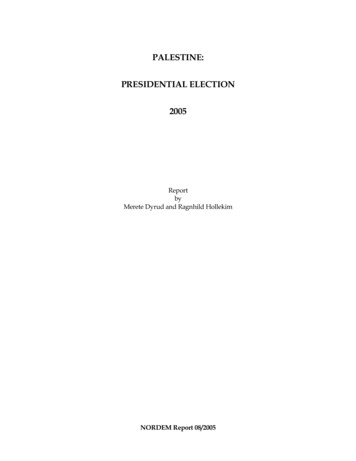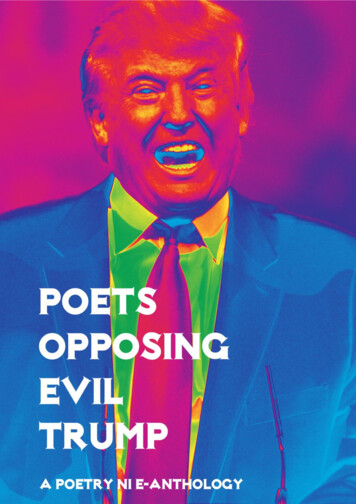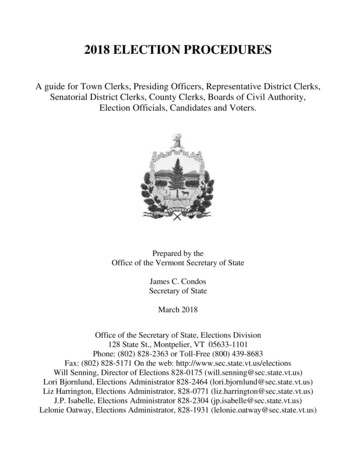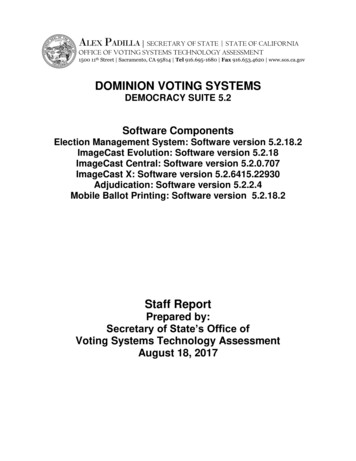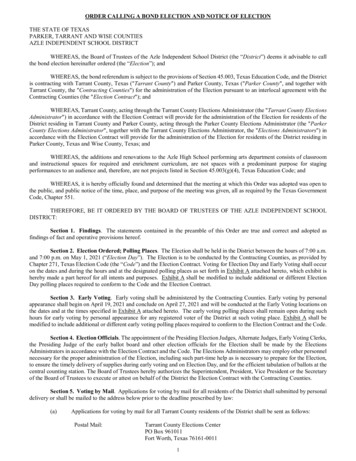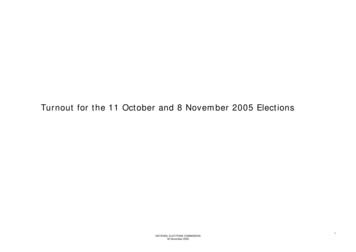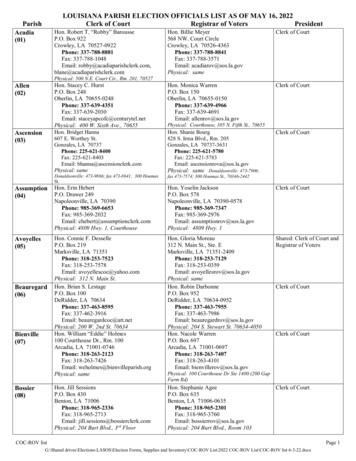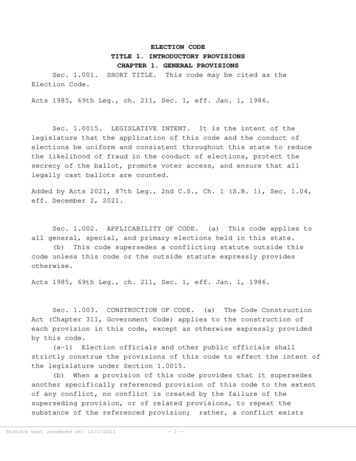
Transcription
ELECTION ADMINISTRATION IN AMERICA –PARTISAN BY DESIGNJeremy GruberJohn OpdyckeThom ReillyJacqueline Salit
Introduction:The United States is one of the few countries in the western world in which partisans runthe election administration system.There is virtually no firewall between electoral competitors and electoral administrators,leaving the voting public at the mercy of shifting partisan currents. The escalatingcontroversies over election outcomes – over who won and who lost and whether thesystem is rigged – would not be possible but for the fact that the system is ALREADYprofoundly partisan. As Edward Foley, director of the election law program at Ohio StateUniversity's Moritz College of Law describes it:We allow partisans to run the system both in the front end of the processand at the back end, and this is particularly problematic at the back endwhen you have a close election.1The 2020 Presidential election brought the issue of how America’s elections are run intosharp focus. Everyday Americans’ concerns over ensuring fair administration of the right tovote were amplified and manipulated. Partisanship at every level-local, state and federal -has shaken Americans’ trust in the entire system. How can voters trust our electoral systemif they think the people in charge are playing for one team or the other?2The vulnerability of partisan administration of elections has been apparent since at least2000, when the Supreme Court's Bush v. Gore decision ended an embroiled Florida recountthat decided the Presidential election. A close election in Ohio in the 2004 Presidential racealmost led to a similar recount that would have involved state election boards and judgesevaluating the same “hanging chads” that fueled the 2000 Florida recount. America’ssystem of election administration has come under increasing scrutiny over the past twodecades, while public trust in that system has deteriorated.Since the 2020 Presidential election, Republican legislators in numerous “red states” havetaken steps to tighten their grip on voting and election procedures. At the same time,Democratic legislators, in the states they control, have worked to jigger the system to theiradvantage. As Russell Berman notes in The Atlantic:1Jeremy Hobson, What Can Florida Do To Improve Its Voting System Before 2020? WBUR, November19, 2018.2For a discussion of how nonpartisan election administration works independently from party politics inCanada for example, see: Nonpartisanship Works, Election Reformers Network -works/1
“Although Democrats like to call out Republicans for trying to suppress voting, thestates they control in the Northeast make casting a ballot more difficult than anywhere else.”3Both sides have had initiatives rejected by the courts on the grounds that they are toopartisan and insufficiently neutral. Thus, a question is raised: How shall democracy-mindedAmericans who are frustrated with partisanship and who value a healthy and dynamicalapproach to managing our economic, social, cultural and international policies respond tothe “line in the sand” strategies of the governing parties? Has the time come to assert a newset of rules and paradigms that reject party control of the electoral process and rest on adifferent set of process needs?Rules for how the two major parties-Democratic and Republican-control the participationand administration of our country’s elections are ingrained at every level of each state’selectoral code. Secretaries of State serve parties, not the public. In many states poll workerpositions are limited to party members and are oftentimes appointed by sitting members ofthe legislature. In even more states, if you are not a registered Republican or Democrat,you are prohibited from serving on the state or local boards of elections as an electionjudge.The role of election administrators is significant. They oversee all aspects of conductingelections and implementing election policies and procedures at the state and local level. Onthe local level, election administrators determine who can vote, where they can vote, andhow they can vote. Their responsibilities include maintaining voter registration lists,drawing precincts, selecting polling place sites, procuring equipment, recruiting, andtraining poll workers, canvassing the vote, and evaluating and implementingimprovements to the electoral process itself. At the state level, election administrationcovers a spectrum of election-related logistics, including the maintenance of the state-widevoter registration file and the implementation of federal and state laws and policiesconcerning elections. This can include ballot design, polling place hours, and provisionalballot use.A recent report4 by the Carter Center highlights the threat to our democracy partisancontrol of election administration poses, finding that it:3Russell Berman, The Blue States that Make it Hardest to Vote, Retrieved 99/. April15, 2021.4Johnson, Kevin, New Models for Keeping Partisans out of Election Administration, The Carter Center,Feb, 1, 2022.2
Essentially communicates that it is only the two leading political parties whoseinterests should be considered in state elections administration, not election officials,not voters, and not independent or third-party candidates.Many of those now waving flags over the partisan character of election administrationwould have you believe this is a new phenomenon.5 It is not new, and it was not establishedovernight. It’s the organic outgrowth of a system with no firewalls, based on a flawedconcept of parity and the self-serving construct that bipartisanship is equivalent tononpartisanship.Parity, not IndependencePolitical parties are designed to compete with each other to win elections. That is their corepurpose. At every juncture, when permitted to do so, the parties design rules to ensure theother party is not advantaged. That is the basis of parity. Party parity has become thefoundational principle of America’s electoral process. This premise is “baked in” at the verytop: the Federal Election Commission. The FEC is the nation’s designated protector ofelection integrity at the federal level. The six members of the Commission are appointed bythe President (after approval by each party’s leaders) and confirmed by the Senate. Everyother federal regulatory commission has an odd number of commissioners, so that thebody can function and pass rulings efficiently and decisively. The FEC has sixcommissioners, three Democrats and three Republicans, as the specifies that no more thanthree members of the FEC can belong to one party, ergo, the FEC is a bipartisan powersharing entity. It is designed to ensure that neither party has an advantage. It also ensuresthat a) enforcement is virtually impossible because crucial votes end in a 3-3 tie, and b)independents, the largest self-identified bloc of voters in the country, have norepresentation.At the state and county level, most boards of elections follow the FEC model. Each majorparty is granted 50% control of the regulatory body, thus ensuring that no party can“game” the rules or the outcome of an election. As long as states were politically diverse,and most Americans were members of the two major parties, this model functioned - albeitimperfectly.675A Democracy Crisis in the Making. How State Legislatures are Politicizing, Criminalizing, and Interferingwith Election Administration. Protect Democracy, States United Democracy Center and Law Forward.April 2, 2021.6Joshua Ferrer, Igor Geyn, and Daniel M. Thompson, How Partisan Is Local Election Administration?,2021.7Richard Hasen, Beyond the Margin of Litigation: Reforming U.S. Election Administration to AvoidElectoral Meltdown, 62 WASH. & LEE 1. REV. 937 (2005).3
The more recent breakdown of this increasingly vulnerable system results from two longterm trends in American politics-the rise of the independent voter and the increasingstratification of states into supermajority control by one of the two major parties. The“partisan parity” paradigm now serves to erode public trust and intensify partisangamesmanship, which in turn further erodes public trust.Why Partisan Parity Doesn’t WorkToday, we are witnessing a major realignment of political affiliation in the United States.Democratic party membership reached its zenith in 1964 at 51% and has been decliningever since. Republican Party membership grew to a high of 31% in 1990 and has sincedeclined.8 Independent voters are now the fastest growing group of registered voters inthe country. They are the largest or second largest group of voters in half the states in thecountry that register voters by party. This growth is across all regions of the United States.At current rates of growth, independent voters will become the largest or second largestgroup of registered voters in 24 of the 30 states that require registration by party by 2035.9What’s more, the Gallup polling organization has found that between 40% and 50% ofAmericans self-identify as independents regardless of the registration requirements in aparticular state.An election system based on major party parity, now completely shuts out a quarter to ahalf of the voting population in each state from playing a role in any aspect of theadministration of the franchise -putting election administration into the hands of anincreasingly small-and increasingly partisan - set of actors.Combine that with the fact that many more states and counties are dominated by one-partysupermajorities than in the past. That means Republican dominated states are becomingmore Republican and Democratic Party dominated states are becoming more Democratic.Very few states with political equilibrium exist anymore. An election administration systembased on major party parity itself has become ill-suited to this political reality.As The Economist recently declared:Partisan election administration is a greater worry today than voter suppression.108Pew Research Center, Trends in Party Identification, 2015. party-id-trend/9The Next Great Migration: The Rise of Independent Voters. John Opdycke and Jeremy Gruber. OpenPrimaries, 2020.10The Real Risk to America’s Democracy, The Economist July 2021.4
THOSE WHO MAKE THE RULES, RULEYou might imagine that if you were to read through the electoral code of any particularstate, you would find a dry recitation of rules for how elections should be conducted toensure a fair and impartial outcome. You would be wrong. Rather, the electoral code ofevery state is ripe with rules for how the two major parties-Republican and Democratprioritize their power at the exclusion of everyone else. There has been some focus of lateon how states choose their top election official, usually the Secretary of State.11 Very littleresearch, though, has focused on how major party interests are “privileged” throughout theentirety of election administration at the state level-an important and broader distinctionfrom some studies that have focused solely on “exclusion” of voters.We reviewed the electoral codes of all thirty states with partisan voter registration systemswhere party membership or alignment is built into the registration process. Key findingsinclude: 27 of the 30 States Restrict or Privilege Boards of Elections, Canvassers or RelatedBoards to Major Party Members. 27 of the 30 States Restrict or Privilege PollWorkers/Watchers/Inspectors/Registrars to Major Party Membership. 11 of 30 States Restrict or Privilege Election Judges to Major Party Membership. 16 of 30 States Privilege Access to Voter Data to Major Party Members. 12 of 30 States have Campaign Finance Laws that Privileges Major Party Members. 19 of 30 States Privilege Major Parties in Voter RegistrationPartisan in State Electoral Codes- Interactive Map Highlights(For a full accounting of the various partisan makeups of state electoral codessee State by State Excel file)Conclusion:Everyone recognizes that in sports, the competing teams should not control the umpires orreferees. Through a complicated process over many decades, that is exactly what we havein the United States. The two major political parties--in parity--control every aspect of11Ballotpedia, Secretary of State by state.5
electoral rule making and administration, despite the fact that most Americans wouldprefer a nonpartisan system of election administration.12Nonpartisan election administration is the norm in most western democracies. Electoralagencies are legally and administratively shielded from political party organizations andactors. The officials tasked with establishing polling sites and counting the votes representthe government, not the parties.We hope this report offers some context for the depth of the problem America is facing.A partisan election system that requires party parity to ensure fairness is vulnerable tomanipulation, now more than ever. There is a growing consensus that nonpartisanredistricting commissions and campaign finance enforcement are necessary to ensuredemocratic outcomes. It is critical that we enlarge this conversation to include nonpartisanadministration of our elections to ensure that election officials are not makingdiscriminatory determinations of who gets on the ballot, who gets to vote, how voter rollsare purged and how votes are counted.No amount of reform will fully address the vulnerability of our election system to partisanmanipulation until we address the very partisan structure of election administration itself.12Alvarez, R. M., & Hall, T. (2005). Public Attitudes about Election Governance. University of Utah Centerfor Public Policy and Administration and the Caltech/MIT Voting Technology Project.6
leaving the voting public at the mercy of shifting partisan currents. The escalating controversies over election outcomes - over who won and who lost and whether the system is rigged - would not be possible but for the fact that the system is ALREADY profoundly partisan. As Edward Foley, director of the election law program at Ohio State
